Menus
- Green danger
- First Euro 4 homologated superbike drive
- Control unit supplemented by a Bosch sensor box
- Blood, sweat and tears
- Chassis one of the biggest innovations
- Anything but stubborn when turning
- New Kawasaki Ninja ZX-10R a big step forward
- Technical data Kawasaki Ninja ZX-10R
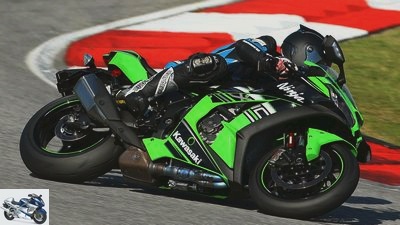
Kawasaki
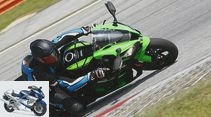
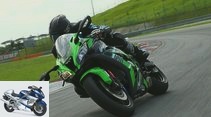

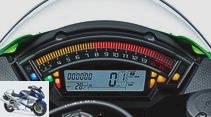
34 photos
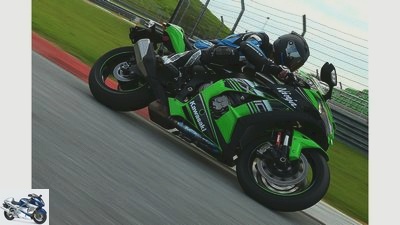
Kawasaki
1/34
Kawasaki ZX-10R (2016).

Kawasaki
2/34
Kawasaki ZX-10R (2016).
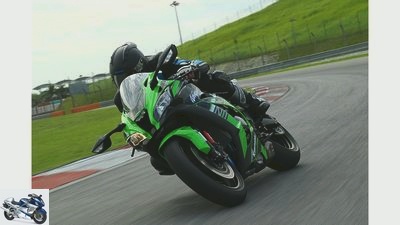
Kawasaki
3/34
Kawasaki ZX-10R (2016).
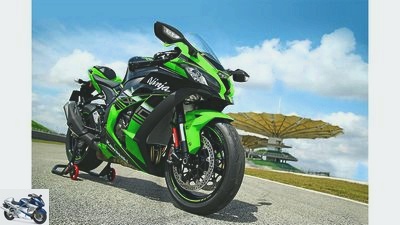
Kawasaki
4/34
Kawasaki ZX-10R (2016).

Kawasaki
5/34
The cockpit was retained from the predecessor. The money flowed in "more important things that do quickly".
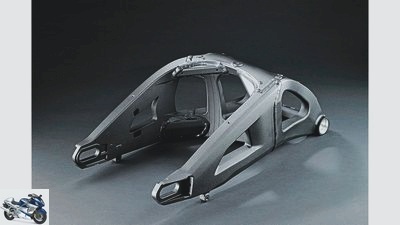
Kawasaki
6/34
For more cornering stability and feedback, the swing arm grew by 15.8 millimeters.
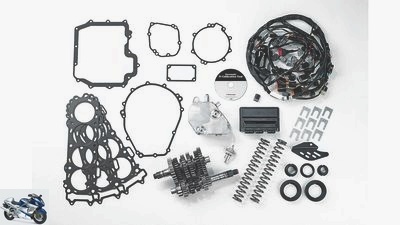
Kawasaki
7/34
Even with the kit control unit, wiring harness and exhaust system, the Kawasaki Ninja ZX-10R is transformed into a radical racing motorcycle with a greedy acceleration from the low revs. In addition, the blipper function is activated via the kit ECU, so it can also be downshifted without a clutch. Unfortunately, the kit parts are only available from selected Kawasaki dealers. The kit exhaust is however available directly from www.kawasaki.de.
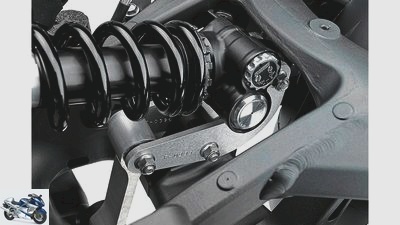
Kawasaki
8/34
The shock absorber works on the principle of the fork and also provides quick changes for small interventions.
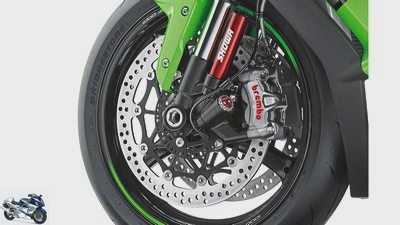
Kawasaki
9/34
The Balance Free fork offers a large adjustment range and reacts immediately to small setup changes. The feedback from the front is a real treat.
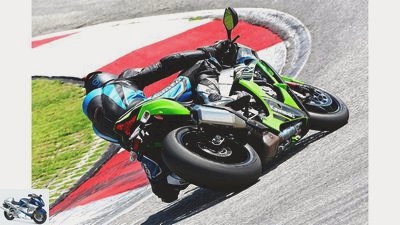
Kawasaki
10/34
“When developing the new ZX-10R, we subordinated everything to the lap time,” explains Yoshimoto Matsuda, father of the current Ninja.
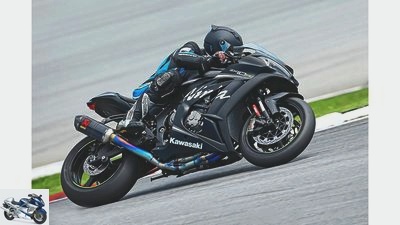
Kawasaki
11/34
If you only want to go to the racetrack with the new Ninja, you should get the racing kit right away.
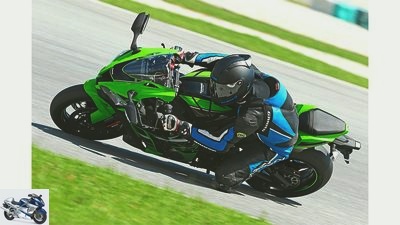
Kawasaki
12/34
The new Kawasaki Ninja ZX-10R is a big step forward for Kawasaki and anyone who wants a green superbike.
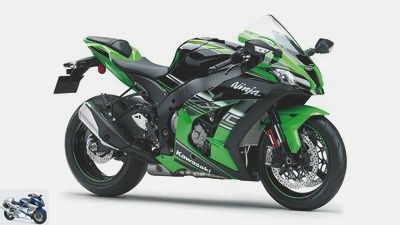
Kawasaki
13/34
Kawasaki ZX-10R (2016).
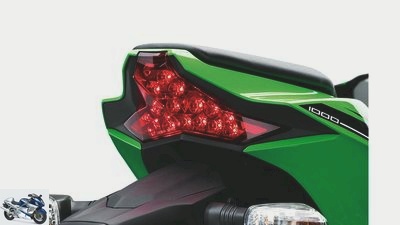
Kawasaki
14/34
Kawasaki ZX-10R (2016).
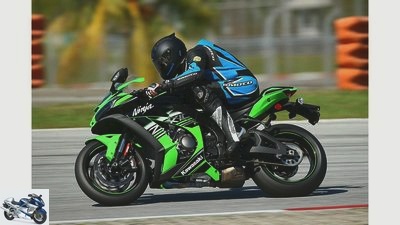
Kawasaki
15/34
Kawasaki ZX-10R (2016).
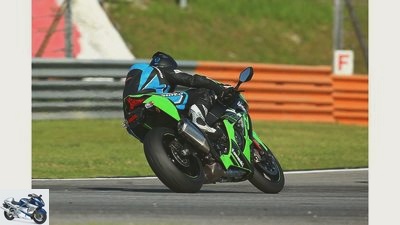
Kawasaki
16/34
Kawasaki ZX-10R (2016).
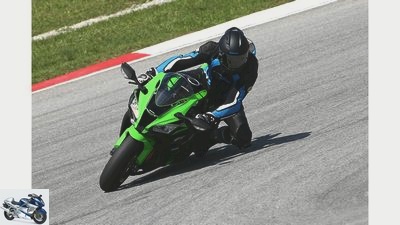
Kawasaki
17/34
Kawasaki ZX-10R (2016).
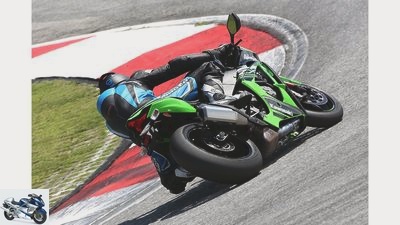
Kawasaki
18/34
Kawasaki ZX-10R (2016).
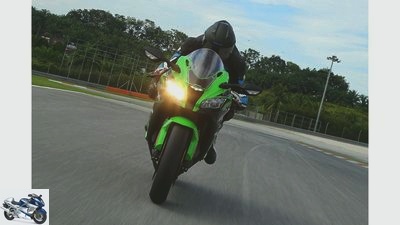
Kawasaki
19/34
Kawasaki ZX-10R (2016).
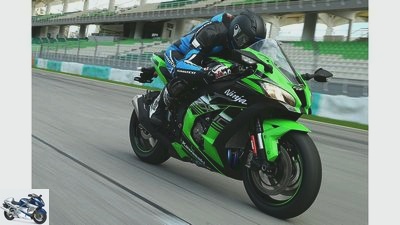
Kawasaki
20/34
Kawasaki ZX-10R (2016).
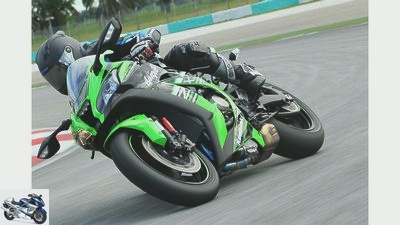
Kawasaki
21/34
Kawasaki ZX-10R (2016).
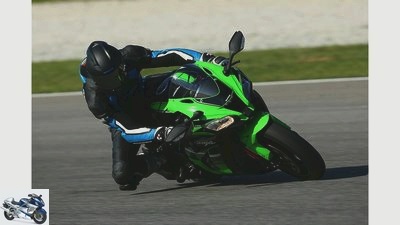
Kawasaki
22/34
Kawasaki ZX-10R (2016).
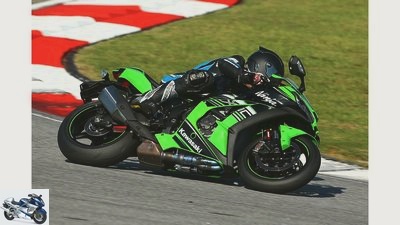
Kawasaki
23/34
Kawasaki ZX-10R (2016).
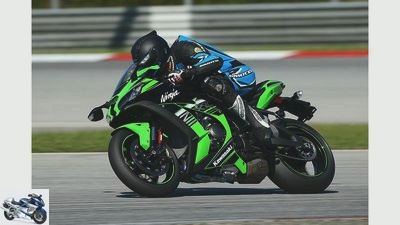
Kawasaki
24/34
Kawasaki ZX-10R (2016).
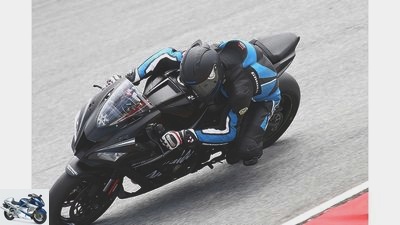
Kawasaki
25/34
Kawasaki ZX-10R (2016).
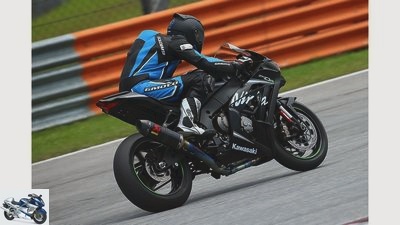
Kawasaki
26/34
Kawasaki ZX-10R (2016).
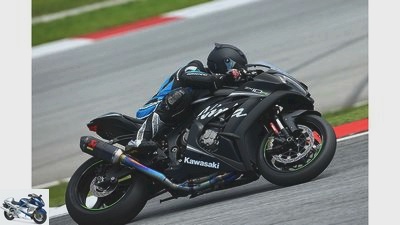
Kawasaki
27/34
Kawasaki ZX-10R (2016).
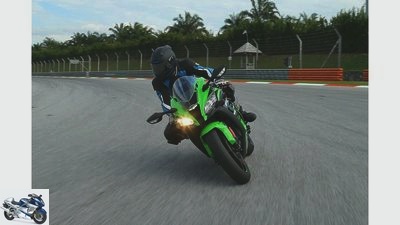
Kawasaki
28/34
Kawasaki ZX-10R (2016).

Kawasaki
29/34
Kawasaki ZX-10R (2016).
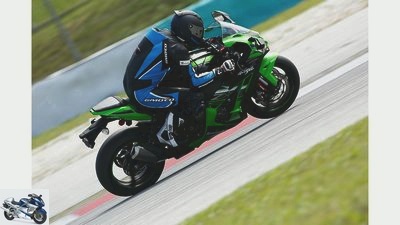
Kawasaki
30/34
Kawasaki ZX-10R (2016).

Kawasaki
31/34
Kawasaki ZX-10R (2016).
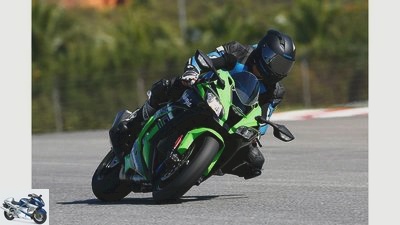
Kawasaki
32/34
Kawasaki ZX-10R (2016).
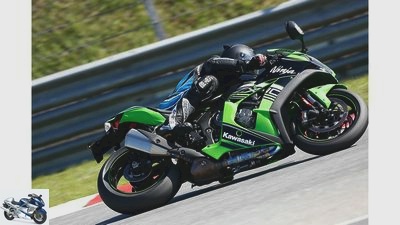
Kawasaki
33/34
Kawasaki ZX-10R (2016).
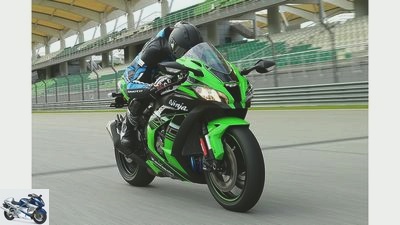
Kawasaki
34/34
Kawasaki ZX-10R (2016).
Kawasaki Ninja ZX-10R in the PS driving report
Green danger
Content of
As the reigning Superbike World Champion, Kawasaki proudly presents the new 1000, the innovations of which also come directly from the factory team from the World Cup. These range from the engine to the electronics and make the Kawasaki Ninja ZX-10R a bitter opponent for the highly armed competition. PS felt this on the Sepang Grand Prix circuit.
The is brightly packaged in the sense of a bold new design Kawasaki Ninja ZX-10R in 2016 really not. At least at first glance. Maybe that’s a mistake from a marketing point of view – but the new ninja remains optically rather understatement. If you value technology and, above all, lap times, visual rumbling should be sausage, because at the end of the day, rideability and lap times are what count on a superbike. “When developing the new ZX-10R, we subordinated everything to the lap time,” explains Yoshimoto Matsuda, father of the current Ninja. “What doesn’t immediately ensure better times was not an issue for us. We preferred to invest money for complex dashboards or the like in quick solutions. “
Buy complete article
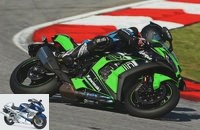
Kawasaki Ninja ZX-10R in the PS driving report
Green danger
Ninja ZX-10R, because the wider cockpit cladding and the slightly differently cut side cladding opening have clear functions. The first ensures better aerodynamics and more wind protection for the pilot, the second for better cooling of the newly made four-cylinder in-line engine.
First Euro 4 homologated superbike drive
It is now the first Euro 4 homologated superbike drive and has a nominal 200 hp. In view of the requirements for volume, exhaust gas and consumption, this is a real pound that the competitors have yet to achieve in the coming year. The most noticeable innovation is probably the revised crankshaft, the moment of inertia of which was reduced by 20 percent at the request of the World Cup team. The new Kawasaki Ninja ZX-10R greedily turns upwards to deliver its maximum power at 13,000 rpm. That’s why you step through the gearbox at lightning speed using the well-functioning automatic gearshift and sweep the long Sepang straight towards the braking point at breathtaking speed. But the new crankshaft also has a positive effect on responsiveness. The four-cylinder engine takes the initial gas command much more gently than its predecessor and reacts far less abruptly to corrections to the throttle valve opening.
In the five-digit speed range, the Kawasaki Ninja ZX-10R was never weak before, but it seems to have improved again. In addition, thanks to the many innovations that range from the cylinder head (including new intake and exhaust ports and cam profiles) to the combustion chambers and pistons to the balance shaft, it should also be stronger in the middle. With the larger airbox and the new throttle valves, there are still two arguments for more power in the middle of the news sheet. The smoothness of the row four is also remarkable. At no time does it annoy you with vibrations and spoil you with an absolutely velvety run.
Control unit supplemented by a Bosch sensor box
Kawasaki has also changed the primary gear ratio. The transmission of the new Kawasaki Ninja ZX-10R is stepped closer between second and sixth gear. The long first course has remained. And unfortunately – at least in the Euro 4 trim – the weakness in performance at low speeds, even if it no longer lasts over a very wide range as with the predecessor. The main problem could now be the Euro 4 homologation, because a version with racing kit parts such as the kit control unit, wiring harness and exhaust that ignores Euro 4 and which we could also drive, rips out of the speed range with the slightest pluck so brutal that you have to hold on to the handlebars.
On the Sepang course, which has a few tight spots, the serial ninja didn’t pull thick slices of sausage off the bread even in first gear below 5000 rpm. But this can also be related to the traction control, which in the Kawasaki Ninja ZX-10R regulates very subtly, i.e. barely noticeably and sometimes slows down the propulsion after the tight bends when it is mercilessly torn open. The system known from its predecessor with the precalculation via the control unit is supplemented in the new Ninja by the Bosch sensor box and now also records the incline, movements around the longitudinal axis and the wheelie and stoppie inclination.
Blood, sweat and tears
Overall, this results in a complex system of calculation and reaction, “with which the Kawasaki Ninja ZX-10R is much closer to the limit than the systems of the competition,” says Matsuda. The calculations of the Kawa engineers are so complex that the data would occupy 50 percent of the company’s own control unit.
Matsuda didn’t want to reveal exactly how this works. Only his pride and the reference to the blood, sweat and tears that this system cost him during his time as a MotoGP developer let us trust it and continue to give full throttle on the next turn at the exit of the corner. No suspicious thing happened.
Chassis one of the biggest innovations
One of the big innovations on the Kawasaki Ninja ZX-10R is of course the chassis with the completely new Free Balance fork and the shock absorber based on the same principle (for function see PS 02/2016). The response behavior of both damper units was impressive. The fork proved this in the very fast right-hand turn number 6, which was tormenting inside with fine waves. With a lot of confidence in the chassis, you could turn the throttle boldly in full incline and keep increasing the speed, the fork led the front wheel sparkling cleanly over the bumpy surface. In addition, the feedback was excellent, you could feel exactly when the bike was pushing downhill over the Bridgestone slick at Turn 3, for example. The same applies to the shock absorber, so that even the riders could not really scare you when you power out in the slightly less grip curve 4. Of course, thanks also go to the new framework for the feedback.
But briefly back to the chassis components of the new Kawasaki Ninja ZX-10R. Their setting range seems enormous, because even minimal setup corrections resulted in noticeable changes in the damping. With increasing speed, we were able to eliminate the slight fidgeting of the handlebars when accelerating out with a quarter turn on the compression stage of the shock absorber and we also eliminated the slight rocking movement of the fork when stepping through the gears with a minimal turn of the compression and rebound stage. Even when switching from series tires to slick, only minimal corrections were necessary. Even more astonishing: Even with the extremely strong, much lighter kit bike (approx. 9 kg) the setting remained almost the same.
Anything but stubborn when turning
In general, the Ninja made a very good impression in terms of driving behavior and handling. Yoshimoto Matsuda already emphasized in the conversation that a lot of development work and the exchange of experiences with the World Cup team went into the chassis of the new Kawasaki Ninja ZX-10R in order to get the best package for all handling issues. The aim was to achieve lightning-fast changes of direction and willing turn-in with high stability in an inclined position and when braking hard. The lighter crankshaft contributes to this.
In addition, there have been corresponding changes to the frame: The steering head tube has been extended by 7.5 millimeters towards the driver, thus achieving more feeling for the front as well as more stability and more confidence at the entrance to a curve – both on the brakes and when turning. The same applies to shifting in fast alternating curves. And indeed: where other superbikes are nervously dancing in the braking area, the Kawasaki Ninja ZX-10R stubbornly stays on course. Nevertheless, she is anything but stubborn when turning, is a lot of fun when driving over the front wheel and inspires with her calmness in fast corners at deep lean angles.
New Kawasaki Ninja ZX-10R a big step forward
The last important point marks the new brake of the Kawasaki Ninja ZX-10R. That’s racing – we exclaim euphorically. The super-light M50 calipers from Brembo with the 5.5 millimeter thick 330 mm washers worked perfectly even in the scorching heat of Sepang throughout the entire test period and impressed with a clearly defined pressure point from the first to the last lap. It couldn’t be better!
Which brings us to the conclusion. The new Kawasaki Ninja ZX-10R is a big step forward for Kawasaki and anyone who wants a green superbike. If you only want to go to the racetrack, you should take care of the racing kit, which is unfortunately not so easy in Germany and certainly not available overnight. Only the kit exhaust is available directly from Kawa without any problems. We want to test both versions – series and kit bike – very soon, then we will see how great the danger in green actually is for the R1, S 1000 RR, RSV4 and Panigale.
Technical data Kawasaki Ninja ZX-10R
Kawasaki
Visually, the new Ninja hasn’t really changed much; technically even more so.
Related articles
-
Kawasaki Ninja ZX-10R – old versus new compared
fact 24 photos www.factstudio.de 1/24 Kawasaki ZX-10R: old versus new. www.factstudio.de 2/24 Kawasaki ZX-10R 2016: Brembo instead of Tokico, “balance…
-
Set the Kawasaki Ninja ZX-10R correctly
Kawasaki 34 pictures Kawasaki 1/34 Kawasaki ZX-10R (2016). Kawasaki 2/34 Kawasaki ZX-10R (2016). Kawasaki 3/34 Kawasaki ZX-10R (2016). Kawasaki 4/34 …
-
Report: 25 years of Kawasaki Ninja
archive 16 photos Kawasaki 1/16 1984: Kawasaki GPz900R Ninja The evolution of the Kawaski from 25 years ago to the present day. Kawasaki 2/16 2003:…
-
SBK-Kawasaki ZX-10R in the PS driving report
Kawasaki 13 photos Kawasaki 1/13 PS Jonathan Reas was allowed to whip the winning Kawasaki ZX-10R exclusively over the slopes in Aragon. It’s just stupid…
-
Kawasaki Ninja ZX-10R after-test the brake
PHOTO-BK.COM 34 pictures Kawasaki 1/34 Kawasaki ZX-10R (2016). Kawasaki 2/34 Kawasaki ZX-10R (2016). Kawasaki 3/34 Kawasaki ZX-10R (2016). Kawasaki 4/34 …
-
New Kawasaki Ninja ZX-10R (2016) in the driving report
Kawasaki 18 pictures Kawasaki 1/18 Kawasaki Ninja ZX-10R. Kawasaki 2/18 Kawasaki Ninja ZX-10R. Kawasaki 3/18 Kawasaki Ninja ZX-10R. Kawasaki 4/18 Kawasaki …
-
Driving report Kawasaki ZZR 1400
Artist Driving report Kawasaki ZZR 1400 (2006) Full program With the ZZR 1400, performance is program: 200 HP make it the most powerful series machine of…
-
Kawasaki H2 and Kawasaki H2R in the driving report
Kawasaki 33 photos Kawasaki 1/33 Kawasaki H2 / H2R. Kawasaki 2/33 Kawasaki H2 / H2R. Kawasaki 3/33 Kawasaki H2 / H2R. Kawasaki 4/33 Kawasaki H2 / H2R….
-
Aprilia RSV4 RF (2017) in the driving report
Photo: Aprilia 22nd photos 1/22 On the track, Aprilia’s RSV4 superbike weapon is a force to be reckoned with. The revised RF version goes one better with…
-
Kawasaki ZX-10R and BMW S 1000 RR in a comparison test
www.bilski-fotografie.de 25 pictures www.bilski-fotografie.de 1/25 Let’s first take a look at the new Kawasaki ZX-10R. www.bilski-fotografie.de …